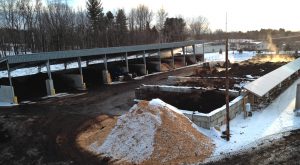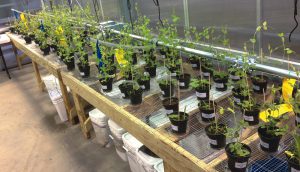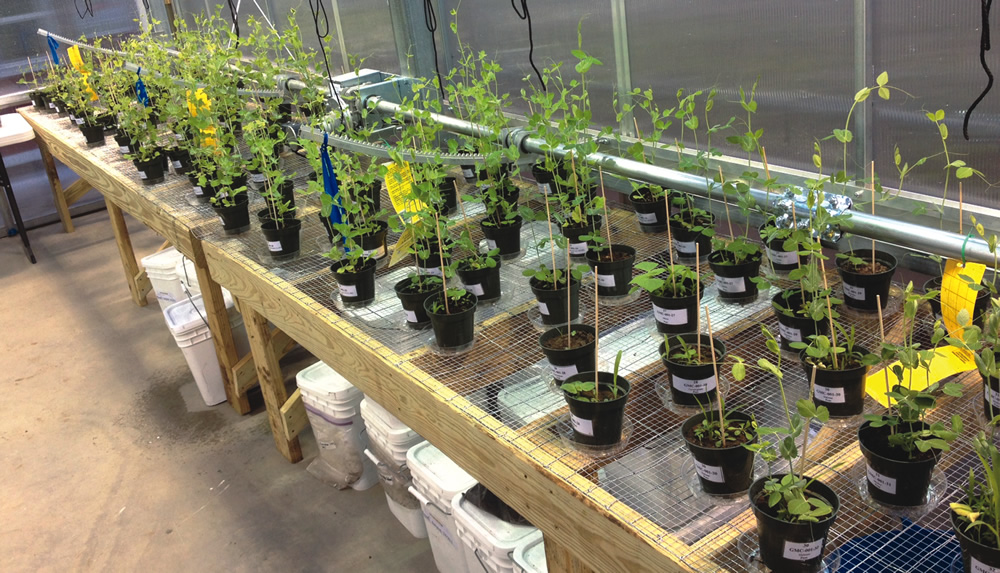An almost year-long investigation into how a Vermont solid waste district’s compost became subjected to persistent herbicide pollution has resulted in answers — and management strategies. Part I
Nora Goldstein
BioCycle June 2013, Vol. 54, No. 6, p. 17

Persistent herbicides at very low parts per billion level can impact sensitive garden plants such as fava beans.
The Chittenden Solid Waste District (CSWD) in Williston, Vermont services 18 municipalities in Chittenden County, with a total population of 156,000. The largest municipality is the City of Burlington. CSWD manages multiple solid waste programs, including a single stream materials recycling facility (MRF), household hazardous waste collection and composting. Its annual operating budget is $9 million.
CSWD owns and operates Green Mountain Compost (GMC) in Williston, which processes yard trimmings, food scraps, manures from chickens and other feedstocks such as burlap coffee bags and chaff. Prior to opening GMC in July 2011, materials were composted at the Intervale composting facility, which CSWD had started operating several years earlier under an agreement with the Intervale Center and the Vermont Attorney General. Composting at the Intervale was done in windrows; at the new site in Williston, CSWD built aerated bunkers for the first phase of composting, followed by curing in windrows. The facility has capacity to process 20,700 tons/year of source separated organics (roughly 80 tons/day).
GMC had been selling compost in both bulk and bags; bagged categories include pure compost, topsoil, potting soil and seed starter. Bulk categories include compost, topsoil, raised bed mix and fortified mulch. All products have compost percentages ranging from 100 percent down to about 20 percent. All the GMC bagged compost products sold in the fall and spring of 2011-2012 were made from compost produced at the former Intervale site and were made from inputs received between early 2010 and early 2011. Most of the compost component sold in bulk form in 2012 came from batches made at the new GMC facility. Bulk compost is primarily sold within 25 miles of the composting site. Bagged products are sold through over 75 retailers and two distributors, primarily in Vermont, New York and Massachusetts.
On June 25, 2012, a problem with persistent herbicides was reported and identified in two gardens in the Burlington area. A plant pathologist and pesticides chief with the Vermont Agency of Agriculture, Food and Markets (VAAFM) identified herbicides as the culprit by that afternoon. CSWD suspended sales of its bulk compost immediately. “By late June 2012, it became evident that we had an issue primarily with our bulk products causing damage to a variety of garden plants,” says CSWD General Manager Tom Moreau. “In all, we received 626 complaints of which 510 were confirmed to have verifiable damage. We ended up paying 449 claims.”
Settling those complaints and retrieving unsold product from GMC’s resellers cost CSWD an estimated $270,000. Additionally, the district’s internal cost for items such as testing, legal services and contractors in regard to solving this issue was estimated to be another $372,000. Finally, the loss in value added sales of products that could not be made or sold due to the presence of persistent herbicides adds another estimated $150,000 to CSWD’s losses. “All told, this persistent herbicide event will cost CSWD an estimated $792,000,” notes Moreau. GMC idled its bagging equipment, but expects to resume bagging in 2014 to have product available for market in 2015.
Testing Protocol
The four persistent herbicides that have been under scrutiny as part of CSWD’s contamination investigation are clopyralid, aminopyralid, picloram and aminocyclopyrachlor. One of the most frustrating aspects of this entire situation, explains Moreau, is the “lack of a ‘standard method’ to test for persistent herbicides in complex matrices such as composts and manures down to the low parts per billion levels where sensitive garden plants display an impact. We learned that only the manufacturers — Dow AgroSciences and DuPont — are currently capable of these analyses and not the government regulators nor private labs. This lack of testing capability prolonged CSWD’s period of uncertainty and contributed to our loss of value added sales. Both Dow AgroSciences and DuPont recognize the need for universally accepted testing methods and have been working to develop these methods that they are sharing.”

Chittenden Solid Waste District opened its new composting site that utilizes aerated bunkers for active composting in July 2011. The cases of persistent herbicide damage occurred less than a year later, leading to serious financial strain on the facility’s budget.
Moreau summarized the testing programs conducted during the first six months of investigation into the compost contamination situation in a January 2013 document that was shared with a persistent herbicides task force created by the U.S. Composting Council. The following is what was known as of late January:
• CSWD sent and paid for 84 samples of feedstocks, animal feeds and composts to Anatek labs in Idaho for analysis in June and July 2012. It appears that their results for clopyralid are accurate, while results for picloram may be overstated and those for aminopyralid are understated. Anatek does not have the capability to test for aminocyclopyrachlor (Imprelis).
• VAAFM sent 68 different samples of feedstocks, animal feeds and composts to Dow, which in turn sent them to Carbon Dynamics. Dow paid for these analyses. The results showed no picloram or aminopyralid present, a few samples with clopyralid and 78 percent with varying quantities of DuPont’s aminocyclopyrachlor (Imprelis). Soon after, DuPont concluded Carbon Dynamics’ results for Imprelis were all incorrect.

Green Mountain Compost conducts plant growth trials (example above) on all batches of compost now produced.
• VAAFM collected 9 compost samples in early September 2012 that were each homogenized and sent out to 7 different laboratories in a round-robin attempt to arrive at the best methodology to determine presence of the four persistent herbicides in compost. This exercise indicates the dilemma of finding the herbicide concentration in composts at levels that can impact sensitive garden plants. Many of the labs could not get their detection levels low enough and the U.S. Environmental Protection Agency’s lab had not yet reported the results by the end of January (and still hasn’t as of June 2013), four months after receiving the samples. It is important to note, though, that DuPont convinced the VAAFM that its aminocyclopyrachlor is not present and Dow AgroSciences has found that its clopyralid and aminopyralid compounds are indeed present in 4 of the 5 GMC samples. It thus appears that Dow’s aminopyralid is the main culprit in causing the damage in GMC’s compost.
• In December 2012, Dow AgroSciences stepped up to analyze the 68 VAAFM samples originally sent to Carbon Dynamics. They also agreed to test a limited number of new samples from CSWD. At the time the summary was written in January, only a portion of the results had been made available but they indicate that the concentration of aminopyralid in the GMC compost dropped down to just above the threshold that can cause impacts, following the removal of horse manure and bedding as a main ingredient in the compost recipe.
Latest Chemical And Bioassay Results
On May 17, 2013, Moreau and Dan Goossen, manager of GMC, submitted a memo to the CSWD Board of Commissioners that summarized the latest chemical and bioassay results, as well as discussed new restrictions imposed by VAAFM on pesticide applicators. The memo also explained risk management practices that GMC has adopted as a result of this experience (to be discussed in detail in Part 2 of this article series).
Dow tested 26 additional samples for CSWD and the VAAFM. (These test results update the findings reported above.) The highlights of this testing include:
• Five were samples of mixed blends of feedstocks just before the composting process starts (pre-aeration). The samples go back to the mixed ingredients from July through November 2012 when GMC was either still incorporating horse manure or impacted wood chips into its recipe. (It was discovered that the wood chips GMC used for amendment became contaminated due to being mixed with the horse manure containing aminopyralid during composting, so when they were screened out and recycled back into the feedstock recipe, they were impacting batches that contained no horse manure.) As expected, all 5 samples had detectable levels of both aminopyralid and clopyralid. The intent was to see if any degradation had occurred through the composting process. That is still an unanswered question but it appears that there might be some degradation of aminopyralid.
• Six were compost samples that had undergone the “active phases” of composting, were screened and had some level of curing. The good news here is that the first batch with no horse manure and without recycled wood chips (it was found that the recycled wood chips had been contaminated with the herbicides and thus were impacting batches that contained no horse manure) had no detectable level of aminopyralid and a slight amount of clopyralid (3.4 ppb dry).
• Eight were archived raw horse manure samples taken in July 2012. The news here is that GMC was able to identify a horse stable in Colchester, Vermont that had a measurable amount of aminopyralid in the horse manure delivered to GMC. The VAAFM has been investigating this and it appears the hay was purchased from a dealer as the stable does not grow any of its own hay. The VAAFM identified a hay dealer who allegedly used aminopyralid on the hay prior to selling the hay to the horse stable, however due to the amount allegedly applied by this dealer, it is possible/likely that there were multiple hayfields belonging to multiple farmers that received applications of aminopyralid and where the hay was sold to local horse farmers.
Goossen ran 40 different plant bioassay samples in the first round of testing using either fava beans, peas, red clover or tomatoes. The University of Vermont’s plant diagnostic clinic assisted GMC with the observations. Highlights of the findings include:
• Of the 11 soil samples that had been impacted last summer, none of the bioassays (peas in this case) showed any herbicide impact in this growth trial except for one that had a slight impact in week 3 that eventually disappeared.
• All the compost or topsoil samples with known or suspected concentrations of aminopyralid exhibited herbicide impact problems.
• Some of the compost with just clopyralid but no aminopyralid showed some impact symptoms that tended to get better as the bioassay lengthened. In other words, the plants showed some symptoms early on, then the symptoms either disappeared or got measurably better as time went on.
• The addition of high carbon ash to some compost samples known to have aminopyralid showed marked improvement. (In response to a question from BioCycle, Goossen notes that it is his understanding that the high carbon ash ties up the aminopyralid and makes it unavailable rather than diluting the soil mix.)
• Sample CA 134, the first compost sample made without any horse manure or recycled wood chips in the recipe, showed no herbicide impact to peas, beans or clover.
New Restrictions
The memo to the CSWD Board of Commissioners reported that the VAAFM, U.S. EPA and Dow AgroSciences all agreed on a new label for the aminopyralid product that describes the necessary precautions to take when using this herbicide (see sidebar). In addition, VAAFM has made all four persistent herbicides — aminopyralid, clopyralid, aminocyclopyrachlor and picloram — “Restricted Use,” which requires a licensed applicator. Additionally VAAFM has established a new “By Permit Only” requirement for all of the persistent herbicides used in Vermont. The agency has notified licensed herbicide retailers of this new program and is currently working out the details for permitting and reporting.
As for day-to-day operations at GMC, Moreau explains that CSWD has started to take samples from every batch of compost that has undergone the six to seven week active phase of composting (under aeration) and has been screened. Growth trials are run on all batches (~ 1 sample every 100 cubic yards) and GMC will not resume use of horse manure until the following conditions can be met:
• Chemical testing is available for all four persistent herbicides by either VAAFM or a commercial lab.
• VAAFM’s new permit system is up and running with the required publicity.
• Horse stables will identify all sources of their hay and the hay dealer certifies that no aminopyralid was used within 18 months of harvesting the hay crop.
• VAAFM can run yes/no analyses on GMC’s feedstocks and screened compost for aminopyralid.
• Calculations show that GMC can utilize horse manure and the finished compost will have clopyralid concentrations that show no impact.
Part 2 of this article series will provide more details on some of the highlights reported in this article, including the responses of Dow AgroSciences and DuPont to the persistent herbicide contamination situation, and the risk management strategies now adopted by Green Mountain Compost. Part 3 will delve into the lab analyses challenges, and research findings related to the fate of persistent herbicides in compost that resulted from analyses conducted for CSWD.










